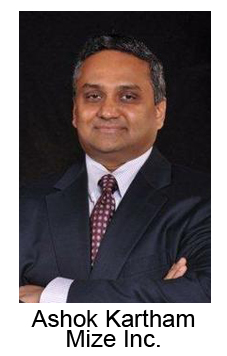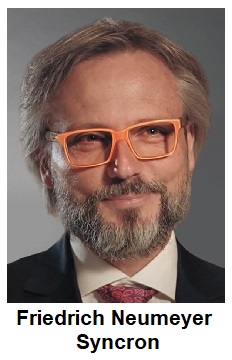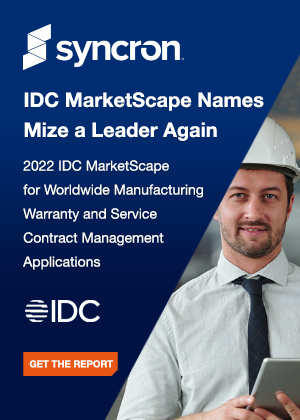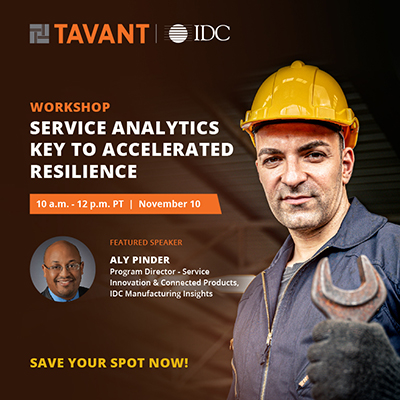Mize Merges With Syncron:
What began as a discussion about how a warranty management and field service solution could be bolted onto an aftermarket service and parts management software platform has culminated in an international merger between an American and a Swedish software company.
The news broke yesterday that Mize Inc., the warranty management software firm founded by Ashok Kartham, is merging with a Swedish company called Syncron AB that specializes in aftermarket and service parts management software. Both companies are privately-held, so there were no details about the value of the transaction or the ownership structure following its conclusion.
Kartham founded Mize in 2012, taking the name from the phrase "Mobilize to Monetize." It was his second go-round at entrepreneurship, having founded the warranty management software industry when he launched 4C Solutions Inc. way back in 1995, when everybody else was using spreadsheets. Ten years ago, after building up 4CS and the warranty management software category, he sold the company to PTC, and moved to Florida, where he decidedly refused to sail off into the sunset.

Even today, he continues to resist the urge to retire. This week, Kartham told Warranty Week that he will retain an ownership stake in Syncron, and will become its Chief Product Officer. Mize employees in Florida and India will be offered positions in the merged company, which will retain the Syncron name, and by the end of the year the combined entity should have a total of 700 employees in 12 offices across eight countries.
Syncron is headed by Dr. Friedrich Neumeyer, a German who goes by the nickname Fritz, and who joined the company as its CEO in June 2020. Immediately before taking on that role, he served as the CEO of enterprise resource planning software vendor proALPHA Business Solutions GmbH for six years, and before that he worked at both SAP S.E. and McKinsey & Company. Back in his school days, Dr. Neumeyer studied nuclear physics and has a Ph.D. from the Technical University of Darmstadt. Though he identifies as German, he has also lived and worked in Italy, Sweden, Belgium, and the U.S.
Relying On Videoconferencing Tools
Neumeyer joined Syncron only a few months into the global health emergency, at a time when most international and even some domestic travel was severely restricted. "It's a really unique experience to join a company in the midst of a pandemic, when you can't meet people physically," he said. "In my role, it is so important to really get the vibes in the room, and the body language." But he had to meet everyone somehow, and so like the rest of us he relied heavily on videoconferencing tools to make those initial contacts.
Now he needs to preside over a merger of people and product lines, in the midst of a pandemic that seemingly refuses to end, which still makes it difficult to cross borders, meet new employees, go to business conferences, or even take a new customer out to lunch. But thanks to the assistance of Kartham, he was able to go on a virtual goodwill tour of the Americas, meeting some Mize customers and educating himself about the warranty management software industry.
Kartham said he thinks that in a way, the first year of the pandemic provided an opportunity to train for the mechanics of this merger, precisely by restricting travel and by making communications technology even more indispensable. "We think this merger makes sense not despite the pandemic, but because of it," he said. "We and our customers learned to do everything remotely. Digitization has accelerated."
And that includes remote service and warranty work, Kartham added, the importance of which has accelerated and grown precisely because of the restrictions brought on by the pandemic. "So we feel like all the trends that were already there -- digitization, and moving towards more products-as-a-service, were accelerated. And we felt like the time is now to come together and deliver a complete service lifecycle management solution to our customers."
Actually, the initial arrival of the pandemic a year-and-a-half ago did in fact derail the first round of discussions of a mere partnership between Syncron and Mize. Kartham said those initial meetings began around the end of 2019, which for all intents and purposes is BC -- Before Coronavirus. Back then, the companies kept running into each other, and had each independently realized that they had very complementary products, which were being pitched to some of the very same customers as separate solutions. But then a few months later, as the pandemic struck, everything was put on hold, as the world slipped into lockdowns.
But then soon after Neumeyer came on board last June, the discussions restarted. "As we got into it again, I think we realized it could be a lot stronger than just a loose partnership," Neumeyer said. And then just in the last eight weeks or so, the discussions escalated to the point where they began talking about a merger. The official announcement came yesterday, in the form of a press release on the Syncron website and on the Mize website. And the merger is effective immediately. Such is the advantage when both merger partners are privately-held companies.
Now comes the hard part: turning the people and products based in Stockholm and Tampa into a cohesive unit. "We are not saying it will be easy," Neumeyer said, "but we are saying it will be done. I am absolutely positive that this can be done successfully, because of the up-front alignment and the similarities between the two companies. I mean, think about even the underlying technology platform. We're both developing based on Amazon Cloud, we're choosing the same Java base for programming languages, and we have a similar approach to creating mobile solutions and business analytic solutions. If that all would be different it would be tougher. But we have that great alignment before, which helps us."
In addition, he said, the companies have done a great deal of preparation around the mechanics of how they're going to bring the people and the products together. "Maybe that's the German in me: It's all about the preparation," he said. "And after all, the most important thing is how you communicate as a team. Everybody views this as an opportunity, because the story is so good."
Predictive Maintenance & Warranty

Neumeyer noted that even before COVID struck, Syncron was already investing heavily into Internet-of-Things technology, into artificial intelligence, and into predictive maintenance, by Internet-enabling vital components on the turbines and engines on ships and planes, so they can be monitored and checked for patterns of behavior typically found before failures.
When those patterns are detected, maintenance appointments can be scheduled at the optimum time for the equipment, before those failures occur. And most importantly during the pandemic, the monitoring and the scheduling can be done remotely, by people who aren't necessarily even in the same location as the customer or the product.
"How great is this now if you can connect this and create a planned service event, because with a ship or an aircraft, you can only service it when it is in the harbor or on the ground," he said.
More importantly, Neumeyer said, the technology can make sure the equipment is fixed as soon as possible and returned to service. "There is a great quote from a current Mize customer, who once said to me, 'Well Fritz, I'm only asked how quickly I can dispatch a technician. I'm never asked if that technician will bring the right part.'"
Syncron focuses on customers in the industrial equipment, automotive, transportation, mining, and construction industries with software products and solutions that help them schedule predictive maintenance, price service parts, and manage parts inventories. Toyota, New Flyer, Brother, Mazda, Manitowoc, Kawasaki, LKQ, Manitou, and Mitsubishi are just some of the well-known customer names on the company's roster.
Neumeyer said the initial discussions with Mize centered around the possibility of some sort of partnership, where Syncron's expertise in aftermarket service management could be teamed up with Mize's expertise in warranty, field service, and service contract management. But he said they soon realized that a mere pledge to work together wasn't deep enough -- it would take some sort of investment by both partners.
"And then we both realized that if we were really serious about this," he said, "if we wanted to truly add value, then we should really and materially invest to create these capabilities. And then we felt maybe we should go the full step and bring these companies together."
Customer Lists
On its website, Syncron lists ten different target industries for its aftermarket management software, of which at least eight are commercial in nature. Meanwhile, on its website, Mize lists eight target industries, of which at least five are on the commercial side of the business.
Where they overlap most completely are in commercial markets such as agriculture, industrial equipment, medical equipment, aerospace, railway, shipping, mining, and construction, in addition to one consumer market: automotive. Syncron has additional target markets such as utilities, energy, oil & gas, while Mize has additional targets such as consumer durables and home warranties. But at their core, they share the same core target markets.
"If we were not aligned on this," Neumeyer said, "there would be no point in bringing the technologies together. Because ultimately, technologies have to solve industry-specific problems for customers who have been using their processes in their specific domains before we came. And that means we have to respect that the whole after-sales, parts, or service management process is fundamentally different for aerospace compared to automotive or agriculture."
"You have to understand the nature of their business and build the software to support the corresponding processes underneath to make it work. And that is a great additional gel between Mize and Syncron, which is why I think this partnership matters so much more than anything else. We could have looked at other companies, but for us it would not have made equal sense at all."
Kartham noted that the fact that both companies were so focused on the business-to-business side of the manufacturing landscape is going to help immensely when it comes time to integrate these formerly separate companies. Customer satisfaction and downtime have different meanings on the commercial side, as compared to the consumer side of warranty. If a piece of mining equipment goes down for a few weeks, it could cost millions of dollars in lost production.
"A majority of our customers are on the commercial or business-to-business side -- heavy equipment and transportation, even though we have a number of consumer durables," Kartham said. "We do think that downtime in these types of products is very critical for their customers, and their customers expect these products to be repaired immediately. I think that maybe that warranty as well as the service are critical for these customers. So we think that this merger will bring not only the warranty side of it, but how we can deliver both parts and service solutions to ensure uptime, which is one of the key things for our customers."
Neumeyer said the companies already shared roughly half a dozen customers such as Kubota, Electrolux, Epiroc, Hitachi, AGCO, and others. Sometimes their respective products are used by people in the same divisions. But, he noticed, they're not usually people at the same desk, and sometimes not even people from the same department.
Some of these customers can employ 20,000 people worldwide in just their service divisions, he said, "so it's not always easy to bridge that chasm." Different tasks such as warranty and inventory operate in different silos, using different tools, even when they're connected to the same operations.
Kartham noted that Syncron and Mize are working with two different divisions of Kubota Corp., for instance. Mize works with Kubota Engine, and Syncron works with Kubota Tractor. So that separation is not merely a theoretical problem.
North America accounts for about half of Syncron's revenue now, but is a much higher proportion of Mize's revenue. Now, that geographical pattern will tip the balance within the merged company in favor of North America. And this is welcome news to Neumeyer.
"For us as a leadership team, success in the North American market is of pivotal importance to prove that the story works," he said. "And while we have been a company founded in Sweden, now with the presence of Mize we are strengthening our U.S. footprint, with all these great customers joining us. And we hope to be able to expand from this even faster."
Mize has additional North American customers such as Paccar, Trimble, LP Corp., and U.S. Medical Equipment Consultants, which Syncron has not yet signed. And then Syncron counts additional customers such as Ford, Nissan, Daimler, CNH, JCB, and Caterpillar, where Mize has not yet gained a foothold.
Creating A Fully-Integrated Company
Now it all has to be brought together. "We clearly envision a fully-integrated company," Neumeyer said, "because after all, what it really needs to start around is the integrated technology foundation -- the platform. I am personally convinced that as a technology company, whatever organizational setup you want, it will have to follow your main paradigm around how you develop products."
First and foremost, Syncron is a platform company, he said, so the merged company will have to be organized around that central structure. "We really feel that the true value of bringing these companies together is to ensure that these solutions work together in an integrated way, based on an integrated technology foundation. This why we want to bring the organization entirely together."
To achieve that, he said, the first step is to integrate the management team. Therefore, he said, it is very important to note that Kartham is joining Syncron as Chief Product Officer, where he can work to bring the separate product lines together.
"Ashok is one of the few people where, if you talk to people in tech about really detailed process problems, Ashok understands those. In the warranty space for sure, but in other spaces as well." So it makes sense to put him in charge of all product development, as the combined companies' Chief Product Officer, he said.
The next step is to bring the sales and marketing teams together. On its website, Syncron has already revised all the descriptions of itself, changing the text from "10 offices in eight countries" to "12 offices in eight countries." The two additional locations, we assume, come from Mize.
In addition to its home base in Stockholm and Malmo, Sweden, Syncron has U.S. offices in Atlanta and Chicago, with additional European offices in Birmingham UK, Munich, Paris, and Warsaw, plus a sales office in Tokyo and a development center in Bangalore, India. Meanwhile, Mize is based in Tampa, Florida, with its Indian development center located in Hyderabad.
On a good day, it's a nine-hour drive between Hyderabad and Bangalore, which Neumeyer does not see as much of a problem. "While the two cities are not close to each other by European standards," he said, "our people are used to working with each other [remotely]. It makes perfect sense for us to strengthen India as a hub, because now we can tap into a talent base in more than one location without adding the complexity of yet another country and culture."
Warranty Management Executive?
So now, for better or for worse, Dr. Friedrich Neumeyer finds himself as the CEO of a warranty management software company, with one of the pioneers of warranty management software serving as his Chief Product Officer. So we asked him, when he was a small boy in Germany, did he ever dream of growing up to be a warranty professional?
"I will try to give you a very honest answer," he said. "I think the warranty industry is one of the most underestimated, least glamorous, but most relevant businesses when it comes to money. I love this industry. I truly love it. I don't care if it's glamorous or not, because I think there is real business attached to this stuff."
"But I will honestly admit that the value and the relevance of the warranty industry is something I had to learn through Syncron. And that learning was amplified by the discussions I had with Ashok and the customers he introduced me to. Warranty management, and warranty itself, is such an important element of a brand promise. It's not only about the cost of downtime. But you think about what you express with a warranty -- the reliability and these type of things."
"I've spent a lot of my life outside of Germany. But all that 'German Engineering' stuff -- isn't that a quality promise? And isn't this quality promise -- this superior experience not even more important part these days? In a world where commoditization is happening left and right, in markets where things are being produced cheaper, I am personally convinced that the problem of warranty is more important than ever before."









